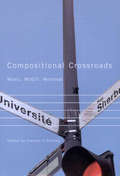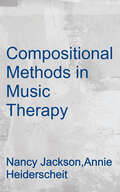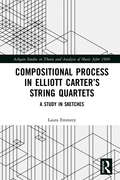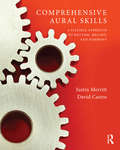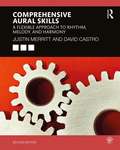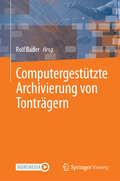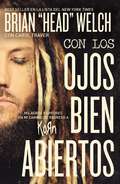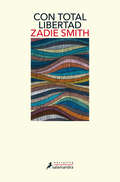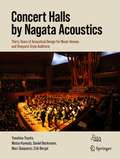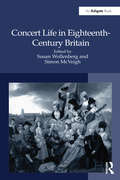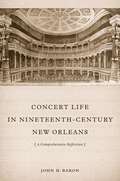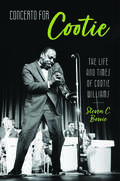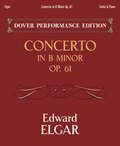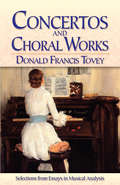- Table View
- List View
Compositional Crossroads: Music, McGill, Montreal
by Eleanor StubleyMcGill University's Faculty of Music - now the Schulich School - has been a centre of new music in Canada for decades, helping to shape contemporary composition, electro-acoustic research, performance, and sound recording. Compositional Crossroads focuses on McGill's location in a culturally dynamic city and shows how the interplay between place, community, identity, and memory and individuals, faculty, and students created institutional pathways that have lead to an explosion of new music activity. Visionary deans, composers, musicologists, and students associated with the Faculty of Music between 1970-2004 offer insights into the early contributions of Istvan Anhalt, the birth of the Electronic Music Studio and McGill Records, the importance of visiting composer-teachers, opportunities for composer/performer collaborations, the development of performing spaces and ensembles, and new ways of considering sonic creativity. Several essays are devoted to major composers who taught at the school, including Bengt Hambraeus, alcides lanza, Brian Cherney, Bruce Mather, John Rea, and Denys Bouliane. Contributors include Robin Elliott (Toronto), alcides lanza (emeritus, McGill), John Rea (McGill), Paul Pedersen (emeritus, Toronto), James Harley (Guelph), Laurie Radford (City University, London), Bruce Mather (McGill), Pamela Jones (author, Montreal), Neil Middleton (Montreal), Steven Huebner (McGill), Jérôme Blais (Dalhousie), and Patrick Levesque (Université de Montreal).
Compositional Methods Of Music Therapy
by Annie Heiderscheit Nancy JacksonSelecting and designing appropriate and effective music therapy experiences involves a critical thought process that considers multiple aspects of the client and their personal, interpersonal, and therapeutic contexts, as well as the nature of the four music therapy methods. Compositional Methods in Music Therapy focuses specifically on procedural guidelines for the compositional method-variations. Case illustrations examine the thought process leading to clinical decisions about the selection of music experiences that are based on the needs of clients and the affordances inherent in music composition. General guidelines for planning and implementing are provided in the form of questions that encourage critical thinking and creativity and which allow understanding of the client to be incorporated into the music therapist’s preparation for sessions. Approaching music therapy planning in this manner provides the foundation for practice that is based in music engagement and makes full use of the potential of music to be transformational in people’s health and well-being. This book is intended for use by pre-internship music therapy students and by professionals who have never approached music therapy planning and implementation from the perspective of the four methods. It is designed to be used either in whole from front to back or in parts in any order in relation to a course or to an individual’s learning needs. Illustrative material is provided to solidify understanding, as well as to connect readers with other resources they can seek out on their own.
Compositional Process in Elliott Carter’s String Quartets: A Study in Sketches (Ashgate Studies in Theory and Analysis of Music After 1900)
by Laura EmmeryCompositional Process in Elliott Carter’s String Quartets is an interdisciplinary study examining the evolution and compositional process in Elliott Carter’s five string quartets. Offering a systematic and logical way of unpacking concepts and processes in these quartets that would otherwise remain opaque, the book’s narrative reveals new aspects of understanding these works and draws novel conclusions on their collective meaning and Carter’s place as the leading American modernist. Each of Carter’s five string quartets is driven by a new idea that Carter was exploring during a particular period, which allows for each quartet to be examined under a unique lens and a deeper understanding of his oeuvre at large. Drawing on key ideas from a variety of subjects including performance studies, philosophy, music cognition, musical meaning and semantics, literary criticism, and critical theory, this is an informative volume for scholars and researchers in the areas of music theory and musicology. Analyses are supplemented with sketch study, correspondence, text manuscripts, and other archival sources from the Paul Sacher Stiftung, the Library of Congress, and the New York Public Library.
Comprehensive Aural Skills: A Flexible Approach to Rhythm, Melody, and Harmony
by David Castro Justin MerrittComprehensive Aural Skills is a complete suite of material for both performance and dictation, covering the wide range of sight singing and ear training skills required for undergraduate courses of study. It provides a series of instructional modules on rhythm, melody, and harmony, and blends musical examples from the common-practice repertory with original examples composed to specifically address particular skills and concepts. Each module includes material for classroom performance, self-directed study, and homework assignments. Features A complete suite of aural skills material: Comprehensive Aural Skills is a combined sight singing and ear training textbook, audio, and companion website package. Fully modular, customizable organization: Instructors can choose freely from the set of exercises in the book and supplemental material on the companion website to appropriately tailor the curriculum based on their students’ needs. Engaging and idiomatic musical examples: Examples are selected and composed specifically for the didactic context of an aural skills classroom. Dictation exercises for practice and assignment: Practice exercises include an answer key so students can work independently and receive immediate feedback, while homework assignments are given without a key. Audio examples for dictation: The website hosts live recordings of acoustic instruments performed by professional musicians for each dictation exercise and homework assignment. Supplemental Materials for Instructors: A wealth of material for class use and assignment can be found on the companion website. Teachers Guide: The guide includes answers for every homework assignment, brief commentary on each module’s content, tips for integrating written theory, and strategies on how to effectively teach new concepts and skills. The companion website for Comprehensive Aural Skills includes a wealth of additional examples in all areas of aural skills and at every level of difficulty represented in the text. Students have access to additional dictation examples with recordings and answer keys, allowing them to directly reinforce their classroom experience and practice dictation on their own time.
Comprehensive Aural Skills: A Flexible Approach to Rhythm, Melody, and Harmony
by David Castro Justin MerrittComprehensive Aural Skills is a complete suite of material for both performance and dictation, covering the wide range of sight singing and ear training skills required for undergraduate courses of study. It provides a series of instructional modules on rhythm, melody, and harmony, and blends musical examples from the common-practice repertory with original examples composed to specifically address particular skills and concepts. Each module includes material for classroom performance, self-directed study, and homework assignments. Features A complete suite of aural skills material: Comprehensive Aural Skills is a combined sight singing and ear training textbook, audio, and companion website package. Fully modular, customizable organization: Instructors can choose freely from the set of exercises in the book and supplemental material on the companion website to appropriately tailor the curriculum based on their students’ needs. Engaging and idiomatic musical examples: Examples are selected and composed specifically for the didactic context of an aural skills classroom. Dictation exercises for practice and assignment: Practice exercises include an answer key so students can work independently and receive immediate feedback, while homework assignments are given without a key. Audio examples for dictation: The website hosts live recordings of acoustic instruments performed by professional musicians for each dictation exercise and homework assignment. Supplemental Materials for Instructors: A wealth of material for class use and assignment can be found on the companion website. Teachers’ Guide: The guide includes answers for every homework assignment, brief commentary on each module’s content, tips for integrating written theory, and strategies on how to effectively teach new concepts and skills. This updated Second Edition includes Revised Rhythm module structure, now introducing foundational concepts more gradually Additional examples from the repertory in the Harmony and Melody modules New and improved recordings on the companion website
Computational Musicology in Hindustani Music (Computational Music Science)
by Soubhik Chakraborty Guerino Mazzola Swarima Tewari Moujhuri PatraThe book opens with a short introduction to Indian music, in particular classical Hindustani music, followed by a chapter on the role of statistics in computational musicology. The authors then show how to analyze musical structure using Rubato, the music software package for statistical analysis, in particular addressing modeling, melodic similarity and lengths, and entropy analysis; they then show how to analyze musical performance. Finally, they explain how the concept of seminatural composition can help a music composer to obtain the opening line of a raga-based song using Monte Carlo simulation. The book will be of interest to musicians and musicologists, particularly those engaged with Indian music.
Computational Phonogram Archiving (Current Research in Systematic Musicology #5)
by Rolf BaderThe future of music archiving and search engines lies in deep learning and big data. Music information retrieval algorithms automatically analyze musical features like timbre, melody, rhythm or musical form, and artificial intelligence then sorts and relates these features. At the first International Symposium on Computational Ethnomusicological Archiving held on November 9 to 11, 2017 at the Institute of Systematic Musicology in Hamburg, Germany, a new Computational Phonogram Archiving standard was discussed as an interdisciplinary approach. Ethnomusicologists, music and computer scientists, systematic musicologists as well as music archivists, composers and musicians presented tools, methods and platforms and shared fieldwork and archiving experiences in the fields of musical acoustics, informatics, music theory as well as on music storage, reproduction and metadata. The Computational Phonogram Archiving standard is also in high demand in the music market as a search engine for music consumers. This book offers a comprehensive overview of the field written by leading researchers around the globe.
Computer Assisted Music and Dramatics: Possibilities and Challenges (Advances in Intelligent Systems and Computing #1444)
by Ambuja Salgaonkar Makarand VelankarThis book is intended for researchers interested in using computational methods and tools to engage with music, dance and theatre. The chapters have evolved out of presentations and deliberations at an international workshop entitled Computer Assisted Music and Dramatics: Possibilities and Challenges organized by University of Mumbai in honour of Professor Hari Sahasrabuddhe, a renowned educator and a pioneering computational musicologist (CM) of Indian classical music. The workshop included contributions from CM as well as musicians with a special focus on South Asian arts. The case studies and reflective essays here are based on analyses of genres, practices and theoretical constructs modelled computationally. They offer a balanced and complementary perspective to help innovation in the synthesis of music by extracting information from recorded performances. This material would be of interest to scholars of the sciences and humanities and facilitate exchanges and generation of ideas.
Computergestützte Archivierung von Tonträgern
by Rolf BaderDie Zukunft der Musikarchivierung und der Suchmaschinen liegt im Deep Learning und in Big Data. Algorithmen zum Abrufen von Musikinformationen analysieren automatisch musikalische Merkmale wie Klangfarbe, Melodie, Rhythmus oder musikalische Form, und künstliche Intelligenz sortiert und verknüpft diese Merkmale dann. Auf dem ersten International Symposium on Computational Ethnomusicological Archiving, das vom 9. bis 11. November 2017 am Institut für Systematische Musikwissenschaft in Hamburg stattfand, wurde ein neuer Standard für Computational Phonogram Archiving als interdisziplinärer Ansatz diskutiert. Ethnomusikologen, Musik- und Computerwissenschaftler, Systematische Musikwissenschaftler sowie Musikarchivare, Komponisten und Musiker stellten Werkzeuge, Methoden und Plattformen vor und tauschten Erfahrungen aus der Feldforschung und Archivierung in den Bereichen musikalische Akustik, Informatik, Musiktheorie sowie Musikspeicherung, -wiedergabe und Metadaten aus. Der Standard Computational Phonogram Archiving ist auch auf dem Musikmarkt als Suchmaschine für Musikkonsumenten sehr gefragt. Dieses Buch bietet einen umfassenden Überblick über das Gebiet, geschrieben von führenden Forschern aus aller Welt.
Computers and Creativity
by Jon Mccormack Mark D’invernoThis interdisciplinary volume introduces new theories and ideas on creativity from the perspectives of science and art. Featuring contributions from leading researchers, theorists and artists working in artificial intelligence, generative art, creative computing, music composition, and cybernetics, the book examines the relationship between computation and creativity from both analytic and practical perspectives. Each contributor describes innovative new ways creativity can be understood through, and inspired by, computers. The book tackles critical philosophical questions and discusses the major issues raised by computational creativity, including: whether a computer can exhibit creativity independently of its creator; what kinds of creativity are possible in light of our knowledge from computational simulation, artificial intelligence, evolutionary theory and information theory; and whether we can begin to automate the evaluation of aesthetics and creativity in silico. These important, often controversial questions are contextualised by current thinking in computational creative arts practice. Leading artistic practitioners discuss their approaches to working creatively with computational systems in a diverse array of media, including music, sound art, visual art, and interactivity. The volume also includes a comprehensive review of computational aesthetic evaluation and judgement research, alongside discussion and insights from pioneering artists working with computation as a creative medium over the last fifty years. A distinguishing feature of this volume is that it explains and grounds new theoretical ideas on creativity through practical applications and creative practice. Computers and Creativity will appeal to theorists, researchers in artificial intelligence, generative and evolutionary computing, practicing artists and musicians, students and any reader generally interested in understanding how computers can impact upon creativity. It bridges concepts from computer science, psychology, neuroscience, visual art, music and philosophy in an accessible way, illustrating how computers are fundamentally changing what we can imagine and create, and how we might shape the creativity of the future. Computers and Creativity will appeal to theorists, researchers in artificial intelligence, generative and evolutionary computing, practicing artists and musicians, students and any reader generally interested in understanding how computers can impact upon creativity. It bridges concepts from computer science, psychology, neuroscience, visual art, music and philosophy in an accessible way, illustrating how computers are fundamentally changing what we can imagine and create, and how we might shape the creativity of the future.
Computers in Music Education: Amplifying Musicality
by Andrew BrownComputers in Music Education addresses the question of how computer technologies might best assist music education. For current and preservice music teachers and designed as a development tool, reference resource, and basic teaching text, it addresses pedagogical issues and the use of computers to aid production and presentation of students’ musical works. Written by a music educator and digital media specialist, it cuts through the jargon to present a concise, easy-to-digest overview of the field, covering: notation software MIDI sound creation downloading music posting personal MP3s for mass distribution. While there are many more technical books, few offer a comprehensive, understandable overview of the field. Computers in Music Education is an important text for the growing number of courses in this area.
Computing Taste: Algorithms and the Makers of Music Recommendation
by Nick SeaverMeet the people who design the algorithms that capture our musical tastes. The people who make music recommender systems have lofty goals: they want to broaden listeners’ horizons and help obscure musicians find audiences, taking advantage of the enormous catalogs offered by companies like Spotify, Apple Music, and Pandora. But for their critics, recommender systems seem to embody all the potential harms of algorithms: they flatten culture into numbers, they normalize ever-broadening data collection, and they profile their users for commercial ends. Drawing on years of ethnographic fieldwork, anthropologist Nick Seaver describes how the makers of music recommendation navigate these tensions: how product managers understand their relationship with the users they want to help and to capture; how scientists conceive of listening itself as a kind of data processing; and how engineers imagine the geography of the world of music as a space they care for and control. Computing Taste rehumanizes the algorithmic systems that shape our world, drawing attention to the people who build and maintain them. In this vividly theorized book, Seaver brings the thinking of programmers into conversation with the discipline of anthropology, opening up the cultural world of computation in a wide-ranging exploration that travels from cosmology to calculation, myth to machine learning, and captivation to care.
Computing Taste: Algorithms and the Makers of Music Recommendation
by Nick SeaverMeet the people who design the algorithms that capture our musical tastes. The people who make music recommender systems have lofty goals: they want to broaden listeners’ horizons and help obscure musicians find audiences, taking advantage of the enormous catalogs offered by companies like Spotify, Apple Music, and Pandora. But for their critics, recommender systems seem to embody all the potential harms of algorithms: they flatten culture into numbers, they normalize ever-broadening data collection, and they profile their users for commercial ends. Drawing on years of ethnographic fieldwork, anthropologist Nick Seaver describes how the makers of music recommendation navigate these tensions: how product managers understand their relationship with the users they want to help and to capture; how scientists conceive of listening itself as a kind of data processing; and how engineers imagine the geography of the world of music as a space they care for and control. Computing Taste rehumanizes the algorithmic systems that shape our world, drawing attention to the people who build and maintain them. In this vividly theorized book, Seaver brings the thinking of programmers into conversation with the discipline of anthropology, opening up the cultural world of computation in a wide-ranging exploration that travels from cosmology to calculation, myth to machine learning, and captivation to care.
Computing Taste: Algorithms and the Makers of Music Recommendation
by Nick SeaverMeet the people who design the algorithms that capture our musical tastes. The people who make music recommender systems have lofty goals: they want to broaden listeners’ horizons and help obscure musicians find audiences, taking advantage of the enormous catalogs offered by companies like Spotify, Apple Music, and Pandora. But for their critics, recommender systems seem to embody all the potential harms of algorithms: they flatten culture into numbers, they normalize ever-broadening data collection, and they profile their users for commercial ends. Drawing on years of ethnographic fieldwork, anthropologist Nick Seaver describes how the makers of music recommendation navigate these tensions: how product managers understand their relationship with the users they want to help and to capture; how scientists conceive of listening itself as a kind of data processing; and how engineers imagine the geography of the world of music as a space they care for and control. Computing Taste rehumanizes the algorithmic systems that shape our world, drawing attention to the people who build and maintain them. In this vividly theorized book, Seaver brings the thinking of programmers into conversation with the discipline of anthropology, opening up the cultural world of computation in a wide-ranging exploration that travels from cosmology to calculation, myth to machine learning, and captivation to care.
Con los ojos bien abiertos: Milagros y errores en mi camino de regreso a KoRn
by Brian WelchTras darse cuenta de que estaba estropeando su vida, y peor aún, la de su hija Jennea, debido a sus excesos en las drogas, el alcohol y la fiesta salvaje, Brian "Head" Welch, guitarrista de la banda KoRn, experimentó un impresionante despertar espiritual que le cambió la vida y lo liberó de la subyugación que implican las sustancias tóxicas. Decidió abandonar en 2005 la exitosa banda que había fundado en 1993, para sanarse. Lo que vino a continuación fue una prueba de fuego que duró una década, desde las dificultades de ser padre de una adolescente extraviada en la depresión y la auto-mutilación, a la dura realidad de tocar solo y sobreponerse a la desgarradora traición de un amigo de toda su confianza. En esta inspiradora saga de redención, quizás la más vivificante sea la radical decisión de Brian de reintegrarse a KoRn y reconciliarse con esa tribu de personas a las que alguna vez consideró su familia, en el horizonte musical del metal. Brian volvió a sus raíces musicales con la cabeza clara y el corazón devoto. Aunque su historia es salvaje, hilarante y profundamente conmovedora, el mensaje es simple: Dios te amará en la libertad de ser tú mismo, siempre y cuando mantengas una relación viva con Él y nunca, nunca renuncies a ella.
Con total libertad
by Zadie SmithUn libro cargado de agudeza, frescura y empatía que nos ilumina en un mundo cada vez más cambiante y contradictorio. Zadie Smith ha demostrado ser una ensayista brillante y singular, haciendo que cada texto suyo sea un acontecimiento literario por derecho propio. Con total libertad, que recopila algunos de los más celebrados, abarca el amplísimo rango de intereses de Smith: desde todas las facetas de la cultura y la libertad artística hasta los temas más acuciantes de la política y la actualidad, siempre desde una perspectiva original y radicalmente personal. Gracias a su fina agudeza, una frescura contagiosa y una empatía extraordinaria, este libro es una guía imprescindible para entender un mundo, el nuestro, cada vez más complejo y contradictorio. La crítica ha dicho:«Ecléctica en sus gustos y centrífuga en su estilo, Zadie Smith disfruta, como articulista, de ampliar los límites de su pensamiento [...] En la línea de Hazlitt y Orwell, Woolf y Angela Carter.»The Financial Times «Interesante, sagaz [...]¿Se debe leer este libro brillante? ¡Por supuesto que sí!»The Independent «Un libro inteligente, ingenioso y a menudo hilarante que demuestra que (Zadie Smith) es una de las mentes más brillantes de la literatura británica de hoy en día.»NPR «Es un placer exquisito observar a Zadie Smith pensar a lo largo de estas páginas.»The New York Times Book Review «Smith lleva a la escritura de artículos sus dotes como novelista: buen ojo para el detalle, sutiles giros en las frases.»The Boston Globe «Estos ensayos en su conjunto reflejan una mente abierta, vivaz, natural, rigurosa, erudita y seria, ocupada en perfeccionar su manera de ver la vida, la literatura y la relación entre ambas. Smith demuestra que es mucho más que una cabeza adulta y comprensiva sobre unos hombros muy jóvenes. Y lo demuestra con su apasionada, compulsivamente dialéctica y atractiva indagación de la literatura».Los Angeles Times «No importa sobre lo que escriba -su padre, Kafka, Liberia, George Clooney-: colocar cualquier tema dentro del campo magnético de su cerebro incansable basta para volverlo fascinante. Smith [...] tiene el don de mostrarnos cómo lee y piensa; al ver cómo lo hace, uno se siente a su vez más inteligente y observador por ósmosis.»Time
Concept Drums – Bass – Guitar
by Dr Paul FrancisConcept Drums - Bass - Guitar For tomorrow’s music makers This book contains: • Performance and tuition repertoire for HIGHER INSTRUMENTAL POPULAR MUSIC EDUCATION (HIPME). If you fancy a challenge, then give it a go! • CONTEMPORARY GROOVES - Stretch your technical abilities • DOWNLOADABLE BACKING TRACKS - With notated scores • EDUCATIONAL THEORY – An insight into how we learn PLUG IN.... TURN UP THE VOLUME.... 1.2.... 1...2....3....4
Concepts of Time in Post-War European Music (Ashgate Studies in Theory and Analysis of Music After 1900)
by Aaron HayesConcepts of Time in Post-War European Music gives a historical and philosophical account of the discussions of the nature of time and music during the mid-twentieth century. The nature of time was a persistent topic among composers in Paris and Darmstadt in the decades after World War II, one which influenced their musical practice and historical relevance. Based on the author’s specialized knowledge of the relevant philosophical discourses, this volume offers a balanced critique of these composers' attempts at philosophizing about time. Touching on familiar topics such as Adorno’s philosophy of music, the writings of Boulez and Stockhausen, and Messiaen’s theology, this volume uncovers specific relationships among varied intellectual traditions that have not previously been described. Each chapter provides a philosophical explanation of specific problems that are relevant for interpreting the composer’s own essays or lectures, followed by a musical analysis of a piece of music which illustrates central theoretical concepts. This is a valuable study for scholars and researchers of music theory, music history, and the philosophy of music.
Concert Halls by Nagata Acoustics: Thirty Years of Acoustical Design for Music Venues and Vineyard-Style Auditoria
by Yasuhisa Toyota Motoo Komoda Daniel Beckmann Marc Quiquerez Erik BergalThis visually stunning and data rich text catalogs the design of 32 concert halls by world-renowned acoustician Yasuhisa Toyota and his team at Nagata Acoustics, the firm behind the celebrated Walt Disney Concert Hall, the Hamburg Elbphilharmonie, and numerous others. Alongside architectural drawings and photographs, commentary on the design process and challenges of each hall provides insight for the dedicated listener to appreciate a wide range of internationally beloved concert venues. Summarized acoustical and architectural data for each of the halls will provide valuable reference information to architects and acousticians alike. Following the project anthology is an overview of the history, development, and acoustical features of vineyard- and surround-style concert halls. A broader discussion of design philosophy reveals the methods by which Toyota has guided architects to create world renowned halls. These technical and general discussions give architects the foundation to design for the performing arts, and provide audiences a new insight and perspective to consider the next time they attend a concert.
Concert Life in Eighteenth-Century Britain
by Susan Wollenberg Simon McVeighIn recent years there has been a considerable revival of interest in music in eighteenth-century Britain. This interest has now expanded beyond the consideration of composers and their music to include the performing institutions of the period and their relationship to the wider social scene. The collection of essays presented here offers a portrayal of concert life in Britain that contributes greatly to the wider understanding of social and cultural life in the eighteenth century. Music was not merely a pastime but was irrevocably linked with its social, political and literary contexts. The perspectives of performers, organisers, patrons, audiences, publishers, copyists and consumers are considered here in relation to the concert experience. All of the essays taken together construct an understanding of musical communities and the origins of the modern concert system. This is achieved by focusing on the development of music societies; the promotion of musical events; the mobility and advancement of musicians; systems of patronage; the social status of musicians; the repertoire performed and published; the role of women pianists and the 'topography' of concerts. In this way, the book will not only appeal to music specialists, but also to social and cultural historians.
Concert Life in Nineteenth-Century New Orleans: A Comprehensive Reference
by John H. BaronDuring the nineteenth century, New Orleans thrived as the epicenter of classical music in America, outshining New York, Boston, and San Francisco before the Civil War and rivaling them thereafter. While other cities offered few if any operatic productions, New Orleans gained renown for its glorious opera seasons. Resident composers, performers, publishers, teachers, instrument makers, and dealers fed the public's voracious cultural appetite. Tourists came from across the United States to experience the city's thriving musical scene. Until now, no study has offered a thorough history of this exciting and momentous era in American musical performance history. John H. Baron's Concert Life in Nineteenth-Century New Orleans impressively fills that gap.Baron's exhaustively researched work details all aspects of New Orleans's nineteenth-century musical renditions, including the development of orchestras; the surrounding social, political, and economic conditions; and the individuals who collectively made the city a premier destination for world-class musicians. Baron includes a wide-ranging chronological discussion of nearly every documented concert that took place in the Crescent City in the 1800s, establishing Concert Life in Nineteenth-Century New Orleans as an indispensable reference volume.
Concert Piano Repertoire: A Manual of Solo Literature for Artists and Performers
by Albert FaurotListing of classical musical pieces written for the solo piano player
Concerto for Cootie: The Life and Times of Cootie Williams (American Made Music Series)
by Steven C. BowieJazz legend Cootie Williams left home to start his career as a professional musician at the age of fifteen. In 1940, after eleven years as one of the major soloists with the Duke Ellington orchestra, Williams was lured away to the band of Benny Goodman, one of the most popular bands in the country. At the time, it was a controversial move—it was still taboo for African Americans to share the bandstand with white people. Current references reduce it to a song written by Raymond Scott, "When Cootie Left the Duke." In reality, it was a seismic event. The Black press predicted Black bands would collapse from raids on their ranks. White musicians were afraid they would be put out of work. And the white press stirred up visions of Black musicians mixing with white women in the new landscape of integrated orchestras.The twenty years trumpeter Williams spent as a band leader (1942-1962) have been covered in only the barest of details. His involvement in politics and the civil rights movement have not been detailed before. An astute talent scout, Williams and his band launched the careers of Eddie “Cleanhead” Vinson, Earl “Bud” Powell, Eddie “Lockjaw” Davis, and Pearl Bailey. He also was the first to record the music of a young Thelonious Monk, using two of Monk's compositions (“Epistrophy” and “‘Round Midnight”) as theme songs for his band. Steven C. Bowie respectfully tells Williams’s story, from his Alabama ancestry onward, including many new details rediscovered from the historical archives of the African American press and those gleaned from the author’s interviews with his friends and colleagues.
Concerto in B Minor Op. 61: with Separate Violin Part (Dover Chamber Music Scores Ser.)
by Edward ElgarOne of the most beloved pieces in the modern violin repertoire, the Concerto in B Minor is among Edward Elgar's longest orchestral compositions and one of the last of his works to achieve and retain popular success. This practice and performance edition contains a piano reduction and a separate violin part.Famed violinist Fritz Kreisler pronounced Elgar the greatest living composer, placing him "on an equal footing with my idols, Beethoven and Brahms. He is of the same aristocratic family. His invention, his orchestration, his harmony, his grandeur—it is wonderful. I wish Elgar would write something for the violin." A commission from the Royal Philharmonic Society helped fulfill Kreisler's wish, and the violinist performed the Concerto in B Minor at its 1910 debut, with Elgar conducting the London Symphony Orchestra.
Concertos and Choral Works: Selections from Essays in Musical Analysis
by Donald Francis ToveyDrawn from the well-known musicologist's celebrated Essays in Musical Analysis, this volume contains nearly all of the concertos in the standard repertoire, from Bach's concerto for two violins to Walton's concerto for viola. More than fifty selections include choral works with in-depth essays on Bach's Mass in B minor, Beethoven's Mass in D, Brahms's and Verdi's Requiems, Haydn's The Creation and The Seasons, and many other landmark works. Donald Francis Tovey's Essays in Musical Analysis ranks among the English language's most acclaimed works of musical criticism. Praised for their acuteness, common sense, clarity, and wit, they offer entertaining and instructive reading for anyone interested in the classical music repertoire.
